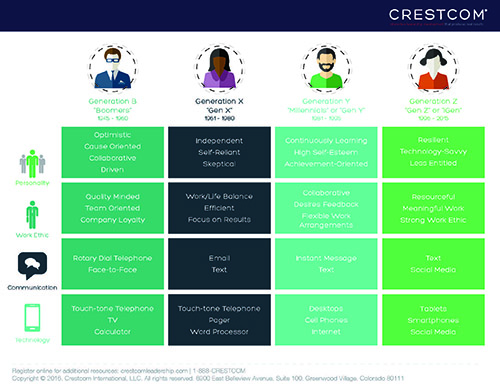Leadership training helps leaders and managers overcome common conflicts and issues in the multigenerational workplace.
We are currently experiencing one of the biggest generational shifts the workplace has ever seen. Baby Boomers are staying in the labor force longer, while Generation Z (people born between 1996 and 2015) are beginning to graduate and enter the labor market in significant numbers. This means that four generations are now represented in the workplace in many companies and organizations around the world.
There is nothing new about generational conflict. Complaining about older and younger generations seems to be a time-honored tradition in virtually every society throughout recorded history. But what does this mean for us as leaders and managers?
Generational Conflict
Tweet this: Have you ever managed a Millennial who would “call-in” sick via text message? Or perhaps you work with or manage a Baby Boomer who will call you on the phone to discuss—at length—the most minute detail that could have been resolved by a quick email? Maybe you have a Gen X employee who leaves work early every Tuesday to take her daughter to ballet class.
Conflict is just one of the issues that a lack of generational intelligence and collaboration can cause in your workplace. Common generational conflicts in the workplace include communication, work ethic, and work/life balance.
Depending on how you value work/life balance and prefer to communicate, these scenarios maybe a little bit of an annoyance to you. Even worse, they may also be causing a rift within your team as well. Jerry, who always works from 9 to 5 on the dot, might see Karen leaving at 4 on Tuesdays and think she is skipping out. What he doesn’t see is that she works until 6 or sometimes even 7 o’clock many other nights of the week.
While it may seem easier to attribute conflicts among your team as simply generational and move on, particularly these days with generational topics so top-of-mind, resolving these conflicts must involve a deeper look into potential underlying issues and individual needs. A report by the Society for Human Resource Management (SHRM), titled Generational Conflict At Work: Separating Fact From Fiction, makes the argument that leaders can move beyond generational conflict in the workplace by understanding other factors that may be causing friction among your team. These include understanding what employees want or need as a function of their life and/or career stage, focusing on development and advancement for job type and level, and recognizing that conflict is often about power and control, rather than generations.
Tweet this: Multigenerational Leadership training empowers managers to get beyond generational conflict. using specific communication and collaboration techniques. For example, start a dialogue with your team to understand how they expect to be communicated with and what they are looking to achieve in their careers and personal lives. Also make your expectations for communication, attendance, and production clear. If you absolutely can not stand that Ryan texted you to tell you that he would be out sick today, let your entire team know what the proper protocol is. You don’t have to call out individuals to tell them that they did something wrong in front of the group, just make it a general review or update of what your rules and expectations are.
Retention Issues
Tweet this: What is your employee turnover rate? The average turnover rate in the U.S. for 2016 is 18.1% (up from 16.4% in 2015). How does your turnover rate compare? If you’re at or below average, leadership training may be a good fit for you and your team.
Employee turnover costs companies A LOT of money each year. Turnover needs to be addressed as the job market continues to strengthen and employees have more options for growth. Based on U.S. Labor Statistics, the labor force is now quitting at about the same rate as they were prior to the global recession, in aggregate.
With a strong job market and flat wages, employees are quitting for the simple economic fact that they can make more money by making a move. In his 2014 article, Employees Who Stay In Companies Longer Than Two Years Get Paid 50% Less, Cameron Keng outlines why this behavior makes sense. While the average employee in the U.S. can expect a 1.3% to 4.5% annual raise (based on performance), leaving means an average increase of 10% to 20%! While employees have little to no influence over management’s decisions to award raises, they do have the power to find someone who will. This decision can cost you quite a bit of money, not to mention the potential loss of talent, experience, and institutional knowledge the leaves with them.
Much has been said and written about Millennial job hoppers, but Millennials have been experiencing an economic squeeze between stagnant wage growth and a combination of skyrocketing student loan debt and housing costs since the beginning of their careers. For most Millennials, the decision to move on (and up) is not just a career choice, but also made out of the basic desire to purchase their own home and start a family. Millennials have simply found that moving jobs has increased their earnings, at least in the short term, and have taken advantage of it.
Turnover studies estimate that the cost of replacing a salaried employee ranges from 6 to 9 months’ salary to up to 213% of the employee’s annual salary! These costs include everything from the cost of finding and hiring a new employee to the impact on team engagement and productivity. For higher-level, and earning, employees this cost is going to be more on the high side of this range. This means that, while leaders are becoming deeply concerned about the Millennial turnover rate, they also need to make sure they are retaining their more experienced talent as the cost of replacing them is much higher.
Multigenerational leadership can impact your retention rate by providing leaders with the generational intelligence they need to retain talent across the generational spectrum by reducing generational conflict and aligning with generational values. A generationally diverse team holds great opportunities for you and your company. Collaborative sharing of knowledge and experience, ideas, and perspectives across all generations mean that your team will develop well-rounded skills that impact the quality of your products and/or services. Teams that can build personal relationships like the Boomers can be as efficient as Gen X, and tech-savvy as Millennials and Gen Z are unstoppable business developers and customer experience ambassadors.
Execution Issues
When teams can’t collaborate effectively to execute initiatives, your business suffers. Customers are not being served at the highest level, and you are not producing products or services at peak productivity. While a lack of communication and collaboration can have many causes, a little bit of generational intelligence can go a long way in fixing it.
Leaders are finding it tricky to create a workspace that is relevant to younger generations while maintaining processes that appeal to what Baby Boomers are comfortable with. A Wired Magazine article, How Do We Prepare For Generation Collaboration? discusses democracy to bridge the gap. Democratization, the article argues, creates an environment where ideas can be shared by all and transparency is key. All the generations in the workplace want to feel as though they are respected and valued by their colleagues. Creating a democratic workplace allows each person to directly contribute and collaborate with others, while personally benefitting from others’ perspectives, experiences, and ideas.
Multigenerational collaboration brings the team together, helping them to understand how each person thinks and the value that they bring to the team. It breaks down silos and encourages productive growth.
What is multigenerational leadership training?
Generational leadership expert, Amy Lynch, once said, “Each of us makes a choice. We sink into ageism, or we learn generational intelligence.”
Multigenerational leadership training helps leaders and managers develop their generational intelligence by bridging the gap between generational stereotypes and conflict to shared values and generational collaboration. It helps leaders develop plans to attract and retain a multigenerational team, and it helps leaders learn to ask questions, to open a dialogue, and to unite their team under shared goals and values that everyone can engage in, no matter their age.





